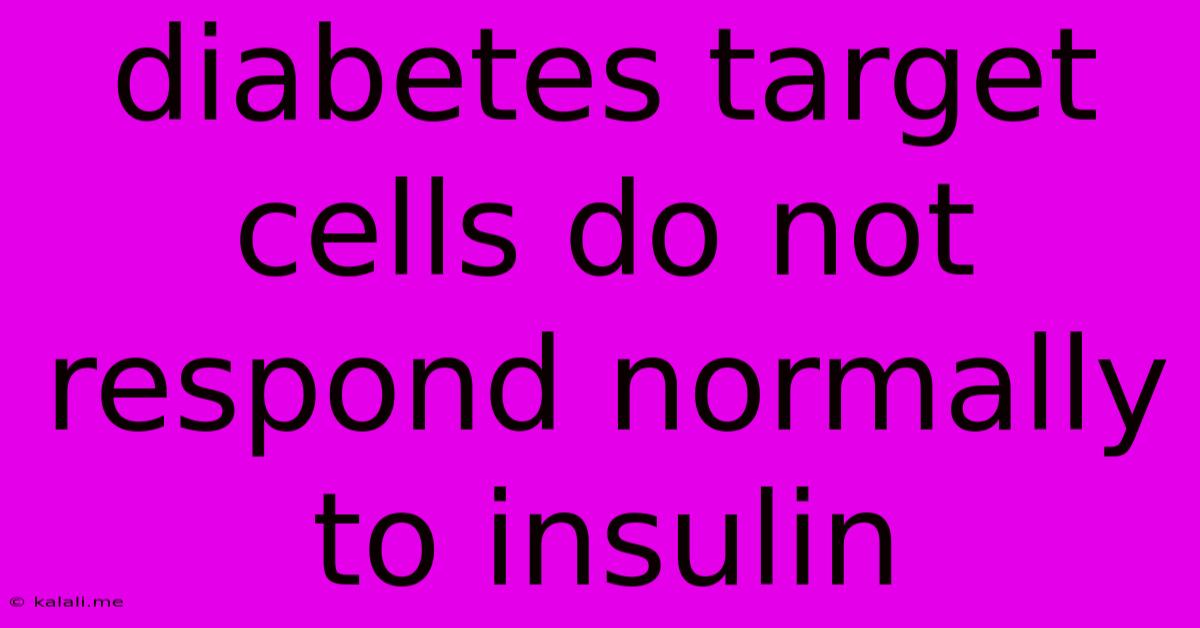Diabetes Target Cells Do Not Respond Normally To Insulin
Kalali
May 09, 2025 · 4 min read

Table of Contents
Diabetes: Why Target Cells Don't Respond Normally to Insulin
Insulin resistance, a hallmark of type 2 diabetes, describes the situation where your body's cells fail to respond effectively to insulin. This means that even when insulin is present, glucose doesn't get transported into the cells as it should, leading to high blood sugar levels. Understanding why this happens is crucial for managing and potentially preventing this prevalent disease. This article delves into the complex mechanisms behind insulin resistance and the resulting inability of target cells to respond normally to insulin.
The Insulin Signaling Pathway: A Detailed Look
Before understanding the dysfunction, let's briefly review how insulin normally works. Insulin, a hormone produced by the pancreas, binds to insulin receptors located on the surface of various cells, including muscle cells, fat cells (adipocytes), and liver cells. This binding triggers a cascade of intracellular events, ultimately leading to the translocation of glucose transporter proteins (GLUT4) to the cell membrane. These GLUT4 transporters then facilitate the uptake of glucose from the bloodstream into the cell, lowering blood glucose levels.
This intricate process, the insulin signaling pathway, involves several key steps and proteins. Disruptions at any point can lead to insulin resistance.
Mechanisms Behind Insulin Resistance
Several factors contribute to the impaired response of target cells to insulin:
-
Impaired Insulin Receptor Function: Genetic predisposition can lead to abnormalities in the insulin receptor itself, reducing its ability to bind insulin effectively or to initiate the downstream signaling cascade. This reduces the sensitivity of the cell to insulin.
-
Downregulation of Insulin Receptors: Chronic exposure to high insulin levels (as seen in individuals with prediabetes or those with a propensity towards insulin resistance) can paradoxically lead to a decrease in the number of insulin receptors on the cell surface. This is a compensatory mechanism that reduces further glucose uptake, ultimately exacerbating insulin resistance.
-
Defects in Insulin Signaling Pathways: Various defects can occur within the intracellular signaling pathways downstream of the insulin receptor. These defects can involve impaired activity or reduced expression of key signaling molecules, such as IRS-1 (insulin receptor substrate-1), PI3K (phosphatidylinositol 3-kinase), and Akt (protein kinase B). These molecules are essential for the translocation of GLUT4 and glucose uptake.
-
Inflammation: Chronic low-grade inflammation, often associated with obesity and metabolic syndrome, plays a significant role in insulin resistance. Inflammatory cytokines, such as TNF-α (tumor necrosis factor-alpha) and IL-6 (interleukin-6), interfere with insulin signaling pathways, leading to impaired glucose uptake.
-
Adipokine Dysregulation: Adipokines, hormones secreted by adipose tissue (fat cells), play a crucial role in regulating metabolism. In obesity, the balance of adipokines shifts, leading to an increase in pro-inflammatory adipokines and a decrease in insulin-sensitizing adipokines. This imbalance further contributes to insulin resistance.
-
Endoplasmic Reticulum Stress: The endoplasmic reticulum (ER) is responsible for protein folding and quality control. In situations of metabolic stress (such as obesity and high levels of circulating fatty acids), the ER can become overwhelmed, leading to ER stress. This stress can disrupt insulin signaling and contribute to insulin resistance.
Consequences of Insulin Resistance
The inability of cells to respond properly to insulin results in several significant consequences:
-
Hyperglycemia (High Blood Sugar): The primary consequence is elevated blood glucose levels, as glucose remains in the bloodstream instead of being transported into cells.
-
Increased Risk of Type 2 Diabetes: Persistent hyperglycemia eventually leads to the development of type 2 diabetes, requiring medication and lifestyle changes to manage.
-
Increased Risk of Cardiovascular Disease: Chronic hyperglycemia damages blood vessels, increasing the risk of heart disease, stroke, and peripheral artery disease.
-
Increased Risk of Other Complications: Long-term complications of diabetes include kidney disease, nerve damage (neuropathy), and eye damage (retinopathy).
Strategies to Improve Insulin Sensitivity
While genetic factors contribute, lifestyle modifications play a vital role in improving insulin sensitivity and mitigating the effects of insulin resistance. These strategies include:
-
Weight Management: Losing even a modest amount of weight can significantly improve insulin sensitivity.
-
Regular Exercise: Physical activity enhances glucose uptake by muscle cells, improving insulin sensitivity.
-
Healthy Diet: A balanced diet, low in processed foods, saturated fats, and refined carbohydrates, helps maintain healthy blood sugar levels.
Understanding the multifaceted nature of insulin resistance and the mechanisms behind impaired cellular response to insulin is crucial for developing effective preventative strategies and treatments for diabetes. Continued research into this complex interplay of genetic and environmental factors holds the key to improving the lives of millions affected by this prevalent disease.
Latest Posts
Latest Posts
-
Study Guide For Electricity And Magnetism
May 09, 2025
-
How Much Is 95 Degrees Fahrenheit In Celsius
May 09, 2025
-
What Is 15 Percent Of 85
May 09, 2025
-
85 Is 20 Of What Number
May 09, 2025
-
Alcohol Evaporates Physical Or Chemical Change
May 09, 2025
Related Post
Thank you for visiting our website which covers about Diabetes Target Cells Do Not Respond Normally To Insulin . We hope the information provided has been useful to you. Feel free to contact us if you have any questions or need further assistance. See you next time and don't miss to bookmark.